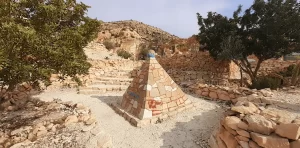
This site contains affiliate links, so I might receive a commission if you click and buy something. It doesn´t cost you any extra, but I could treat myself to some extra snacks to keep me going on my outdoor adventures! Read more in my Privacy Policy
El Cau really is a hidden gem, nested away in the Sierra de Tabaiá / Sierra de Tabaya near Elche.
It is an open-air rock art museum, absolutely jam-packed with rock art: rocks that have been carved and painted, accompanied by poems/writing.
The art is very topical, including pieces related to covid, the role of women in society, local historical events, and familiar local features.
For example, there is a miniature replication of the nearby Elche reservoir system, which fills with water when it rains!
It is also known as EL CAU de Mariano Ros, named after the original creator who died in 2017, although the work has been continued by other artists.
You can read about the history of this place via an interview with the Mariano Ros here (you might need to translate the page into English though).
Looking for ESSENTIAL OUTDOOR GEAR for your mountain adventures?
I came across this place completely by accident one day while I was browsing a map, looking for anything that might be interesting to see or do in the area.
I visited with a friend and I was absolutely blown away. On my first visit, I parked in an impractical location because it looked like a possible access point from the direction that I was driving (I make the mistakes so that you don´t have to!).
However, entering from this direction allowed me to discover a lone piece of art situated away from the rest, unseen by many people who visit. There is also a second lone piece, largely unknown. Both of which you can read about here.
For a couple of years, I felt like this was my secret place, and I couldn´t believe that it was not advertised on the usual “Things to do” websites…until a local travel organisation posted about it.
For this reason, this blog not only includes the museum, but also some routes around the mountains behind. These routes are great for hiking or trail running (I did a bit of both!)
The four route options include a route just to visit the museum, a full route including three different types of caves to explore (for adventurers), and then two routes in-between: a shorter one and a longer one, that both stay on the main path.
There is also a variety of wild camping options, including spots for tents with an awesome view, or sleeping in a bivvy bag in a pod cave!
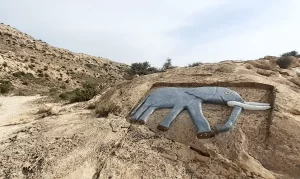
If you love the combination of art and nature, as well as incredible, unique architecture designed by Gaudi, then you will love Park Guell, one of the Best Things to do in Barcelona.
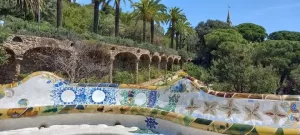
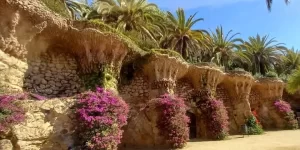
Recommended gear for colder weather:
UNDER ARMOUR 600F Down Parker Jacket (unisex)
Water repellent with zipped pockets and soft knit lining
Looking for more WILD CAMPING spots in the COSTA BLANCA?
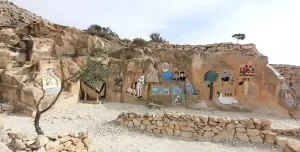
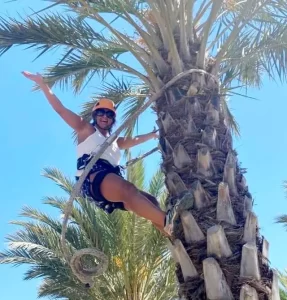
The full route includes:
Prefer hiking in a barranco and visiting natural pools along the way?
There are 4 different hiking routes that are covered in this article:
Visit the rock art museum:
A cultural delight, perfect for anybody who loves the great outdoors.
Full route including all three caves:
This route is perfect for adventurers who want to incorporate hiking/running with scrambling and maybe even spend a night wild camping sleeping under the stars.
Main hiking path – longer route (no caves):
This is perfect for trail runners. The paths are mainly wide and rock-free, and the route is easy to follow so you can concentrate on running!
Main hiking path – shorter route (no caves):
This is a nice hike to gain some elevation, visit a trig point
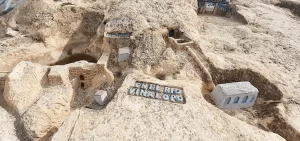
The route to the museum involves a gradual and continuous incline: first along a wide track, and then on a narrower path. But it is quite short: about 1km to get there.
The full route (including all 3 caves) involves scrambling and steep slopes.
Most of this is optional, excluding cave 2 where scrambling is necessary if you want to see and explore them.
The main hiking routes are “regular” hiking routes:
Would you like to swim in crystal-clear cool mountain water?
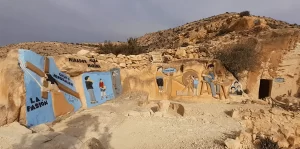
Visiting the museum is great for all of the family, as it is educational. If you appreciate art and culture, then it is great for you too.
However, it is not suitable for pushchairs/prams or wheelchairs, and people with mobility issues might struggle.
You will need to be fairly fit to explore the second cave because this involves descending a big rock via scrambling or with the assistance of a rope.
The main hiking routes are suitable for any hikers who are accustomed to doing the distances stated.
There is no shade along any of these routes. Therefore, the middle of summer is not the best time to do the longer routes.
However, there is a shelter at the museum where you can rest in the cool shade.
I have visited on a hot day, and I liked it because we had the place to ourselves (although I barely see many people there in general). Consequently, we spent some time sunbathing at the top of the quarry/cliff.
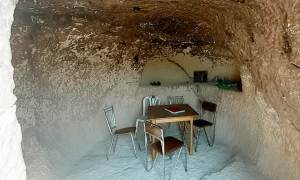
The best place to begin is the dedicated carpark.
This is the “main entrance” that is signposted.
You could also park here, but it is a dead-end road with space for just one car.
This route is not signposted, but quite easy: just follow the path towards the west. However, there is a part of the path that might be a little difficult and require use of your hands to scramble up.
However, there is only a few minutes´ drive between the two locations, so you might as well use the official car park.
The actual hike that I did is the full route that includes exploring the three caves…
If you look at this route, you can easily see the main path, and the three detours that I took from it to explore the caves (at 6km, 6.7km and 8.6km).
Therefore, you can choose to opt-out of this if you prefer not to visit any of them.
Recommended gear for colder weather:
SAGUARO Barefoot Boots (unisex)
Water resistant with wide toe, rubber sole and fur lining
From the car park, look towards the mountains and you will see a quarry/cliff (which actually has gear at the top for climbing or abseiling). El Cau is basically down behind this, so that is the direction that you need to go towards.
From the carpark, the route is clearly signposted:
If you are super fit and able, like me, then it only takes 10 minutes to get to the museum.
However, some individuals (who I suspect are not used to hiking) have complained that it is a difficult hike.
You beginning of the hike is the same for all of the four routes.
Looking for accommodation in Elche? Check out this swanky holiday home…
EL CAU open-air rock art museum
There is SO much art to see here.
The path will lead you right to the main area. However, there is also an area of land opposite, towards the Balcón de Elche…
Balcón de Elche
The “Balcón de Elche” (Elche Balcony) is a very small stretch of land situated higher up that the museum, with a quarry/cliff edge on the other side, and a great view looking across towards the Mediterranean Sea.
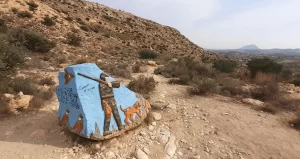
Secret rock art
There are two lesser-known pieces of art, which are all alone, at either side of the
I discovered this piece of art the first time I visited because I parked in the wrong place. That was when I knew I was heading in the right direction!
I only discovered this on my third visit because I spotted it from the mountain. I couldn´t see whether it was art, or just a rock, so I went to investigate. Stay curious!
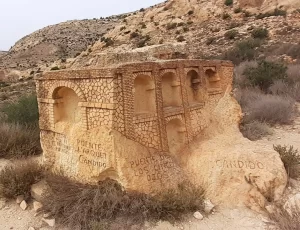
Rest areas
There is a cave-house style shelter at the museum built into the rock. Inside you will find a table, a few chairs, and a notebook where you can record your visit.
There is a second tiny shelter with a rock-carved seating area inside but I´m not sure what the purpose of this is/was.
There are also a couple of outdoor seating areas, which are basically benches and tables carved out of stone. For example, there is this one area right outside of the shelter on the right-hand side, which would be great for a picnic.
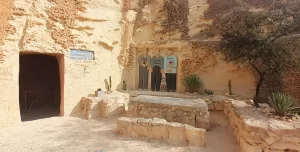
Optional scramble up
To the right of the museum, there is a path leading up the mountain. On my route, you can see that I went straight up at the cairn to take the scrambly route to the top, and later I came down via the normal path. You can choose whatever you prefer.
If you scramble, just head towards the tree and you will meet the path again there.
I actually used this location as a lunch spot on my way back.
Wide track
After the tree, the path because less steep and wider.
On this path, you will pass four towers and a trig point hidden between them.
Tower 1
Walk past this tower and follow the path that turns to the right.
Tower 2
You will pass this tower on your left.
However, after passing it, you need to take a left turn on the path because the trig point is hiding
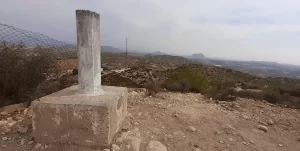
Trig point
This is called a Punto Geodésico at “Alt de Tabaya”.
You can either follow the wide track up to the tower, and then to the trig point behind it, or take the obvious shortcut up the hill (like I did on my route).
From here, you can see the golf course, which is the direction that you will head in if you follow my full route.
When leaving the trig point, you can take another shortcut towards tower 3: Follow the fence on your left and you will meet the main path again.
Prefer EASY HIKING along a WATERWAY with beautiful WATER FEATURES?
Tower 3
When you reach this big gap in the fence, you go through it and turn left, so it seems like you are walking back in a similar direction.
Don´t worry, this is an official path, although it might feel as if you are trespassing.
IGNORE my route, where I accidentally took a right wand walked for a few minutes! (oops)
Tower 4
You cannot access this tower, so you will just pass it on your left.
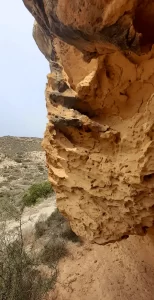
ROUTE OPTION: Main hiking path – shorter route (no caves):
If you want to do the shorter hiking route (on the normal path), then you need to stop following my route, and take a shortcut here.
This will cut out a 147-metre descent immediately followed by 75-metre ascent, and result in a 5.5km long route.
It will also cut out the first two caves, but you could still take a detour to visit the third one.
Let´s run!
After this point, it is a pleasure to run, because there is a 147-metre descent on a wide track.
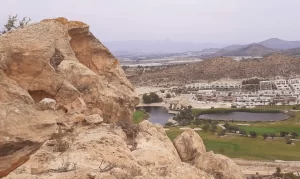
Mini scramble
On the way down, there is a little rocky area where you can have a quick scramble on, and look into the golf course below. It is right next to the path, so why not!
Recommended gear for training:
Smart Boxing machine (Boxing gloves included)
9 modes and 9 speeds
ROUTE OPTION: Main hiking path – longer route (no caves):
If you want to do the longer hiking route on the normal path), then you simply continue on the obvious main path, and do not take the following detour…
Cave 1: “Rincón Oscuro”
This is actually a series of naturally formed caves situated in an area called the “Rincón Oscuro, paraje Los Aljezares” (Dark Corner) which is part of the “Los Aljezares” natural landscape.
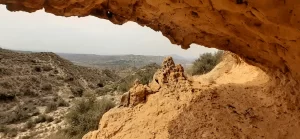
To visit these caves, leave the path here at the 6km mark.
You can choose to walk there, take a look, and return the same way.
Or, you can follow my route which goes up a small “valley” taking a short steeper circular route.
Either way, you will return to the exact same point on the main path.
TOP TIP for Adventurers:
If you like steep slopes, then you can access the first few caves.
However, the actual scrambling is limited. It is not safe to do any vertical scrambling here.
I got excited when I saw the caves because there are several which that are higher up and could be great for wild camping.
However, when I attempted to scramble up to them, pieces of soft rock were coming off in my hands each time I tried!
If you like wild camping, then the first cave would be perfect to sleep in, in a bivvy bag. It is shaped like a pod, and faces the west, so it would be perfect to watch the sunset.
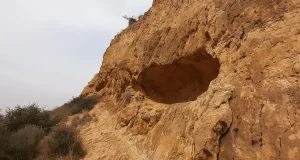
However, if you are just out for a hike, then this is a great place to have a snack/lunch break because it is high up and has an unobstructed view of the landscape opposite.
TOP TIP for Explorers:
The caves appear to continue a little further that I went on my route. From that point, I could see at least two more.
I didn´t continue because I lost interest when I realised that I couldn´t scramble into them…but you might find something interesting!
If you do continue to explore further, then be ready to ascend an extra steep slope up!
Pod cave
For the less adventurous, there is a pod cave right next to the path where you could have a snack/lunch break with a decent view. This could also provide a rest in the shade (if you are there earlier in the day).
TOP TIP for Adventurers: If you like wild camping, just a little further up from this pod cave, there is a nice little wild camping spot, perfect for just one tent. It is very close to, but hidden from the main path, it is high up, and has a great view of the landscape below, including Elche Reservoir and the “Puente de los 5 Ojos”, which is one of the pieces of secret rock art.
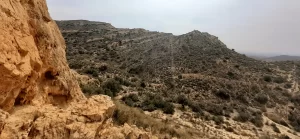
ROUTE OPTION: Main hiking path – longer route (no caves):
If you want to do the longer hiking route on the normal path), continue on the obvious main path, and do not take the following detour…
Cave 2: “Abrigo de las Cabras”
TOP TIP for Adventurers: If you like scrambling, this one is for you! Read below to find out more…
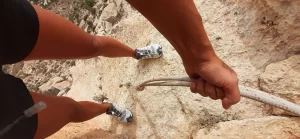
It is only worth taking this detour if you are adventurous and like to explore! …
To visit these caves, you need to leave the path here at the 6.7km mark and take a big triangular-shaped detour away from the main path. Basically, you to go the fence and follow it all the way to the cave.
This is not one cave, but a series or impressive rock formations which you can go down into and explore. Some parts are cave-like, but other parts are just great scrambling opportunities.
It is a steep rocky area called “Abrigo de las Cabras” (which means: Goat´s shelter) presumably because you have to be a mountain goat to get there!
It seems like you can access from above, or from the houses below. I will definitely scramble up it from below another day! If you want to give it a try from below, the starting point is here.
Just a few metres after the 90-degree angle in the fence, you need to go through the hole in the fence. On my route, I actually entered through a much smaller hole before the 90-degree angle, then I discovered this much better one afterwards!
Warning! There is some barbed wire on the floor near the fence, so take care, especially if you decide to go through the smaller hole.
If you walk to the “corner” of the rock, there is a rope which you can go down to begin your exploring. You can also squeeze through the small cave to the left of it. Enjoy!
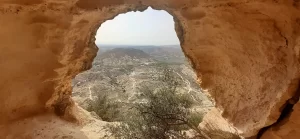
Looking for GUIDED TOURS WITH TRANSPORT from key locations in the Costa Blanca?
The view is outstanding from here, so I recommend stopping and taking in the scenery for a while.
I´m always happy perched on a rock with a big drop below me, so I decided to have a rest and a snack in one of the little “caves”.
To return to the main path you continue to follow the fence up the steep slope until it flattens out.
On my route you will see that I took a detour and went through a hole in the fence to explore, which required me to scramble out. However, you can continue going straight up to the main path if you prefer.
When you reach the path, you will see the four towers again.
TOP TIP for Adventurers:
If you like wild camping there is a flat area if you follow my route through the gap in the fence, which has a great view.
ROUTE OPTION: Main hiking path – longer route (no caves):
If you want to do the longer hiking route on the normal path), continue on the obvious main path, and do not take the following detour…
Recommended gear for adventurers and registered vessel owners:
ACR ResQLink View PLB-425
Floating GPS Personal Locator Beacon. No subscription required
Cave 3: “Corral del Tabaiá”
“Corral del Tabaiá” can be seen from the path, which I left at the 8.6km mark.
It is a structure that has been built into the rock. Some of the front wall has collapsed, but the rest of it is sturdy rock and is therefore quite safe to enter.
“Corral” translates to pen/barnyard, and the area where it is located is called the “Tabaíá” mountain range). Therefore, it must have originally been built for animals to shelter in.
However, it looks more like a cave house with three separate living areas, as well as an outdoor seating area (carved into the rock) for socialising!
There certainly is no evidence of animals using it nowadays.
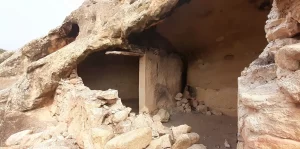
TOP TIP for Adventurers:
If you like wild camping with friends, this would be the perfect place for a group sleeping in Bivvy bags.
It is divided into three areas:
It could accommodate up to 6 people (2 people in each room), depending on personal preferences.
There was evidence that another person has at least spent time here: There was a do-it-yourself camping stove left in the right-side room. However, the place was clean and free from rubbish.
On the way back from this cave to the main path I came across an underground well (empty of water).
I was just contemplating whether I would have been able to get down into it if I had a rope and some pals with me, when I spotted a snake…so, maybe not!
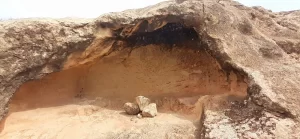
Other natural areas nearby include:
Here are some interesting places that I have visited in Elche city, and recommend…
Plus this Arabic-style teahouse is incredible. It is a real gem located in the countryside of Crevillente, not too far away from Elche (with transportation from Alicante/Elche)…
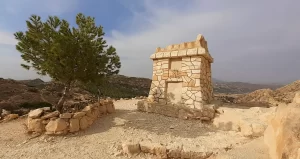
Why not buy me a coffee
to keep me going on my adventures
so that I can share them with you!
Wild Child Costa Blanca
